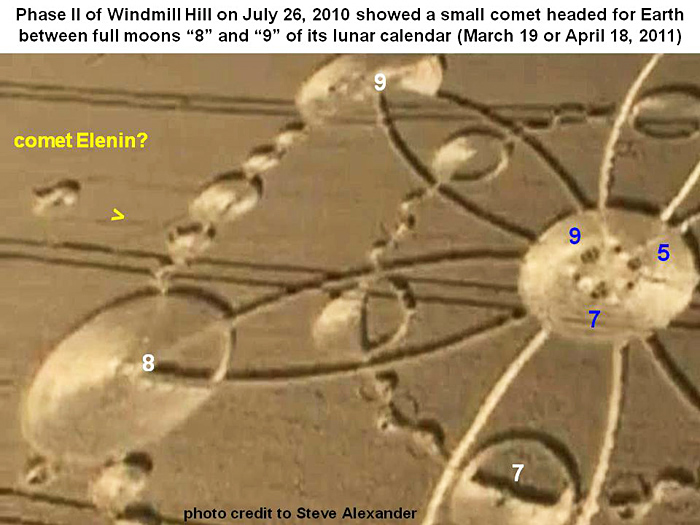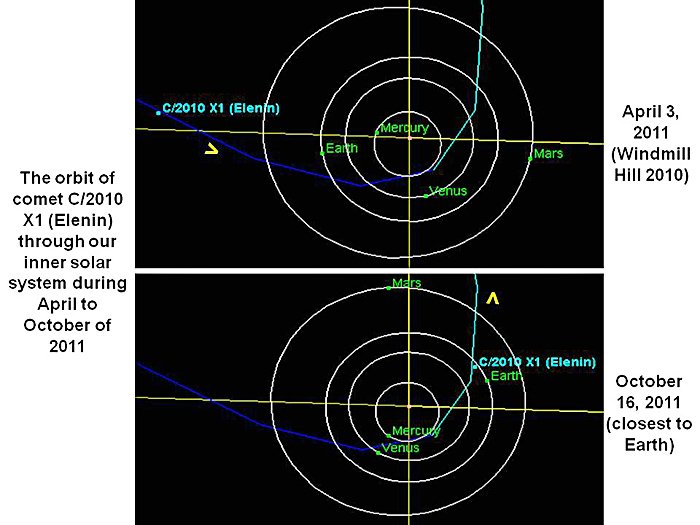|
Phase II of Windmill Hill in July of 2010 showed a “small comet” headed for Earth and Moon in the spring of 2011: a future prediction of Comet Elenin? A newly posted video by Steve Alexander shows a “small comet” headed for Earth and Moon, between full moons “8” and “9” of a lunar calendar drawn in crops, at Windmill Hill in July of 2010 (see 1:00 to 1:15 of www.youtube.com). Those lunar crop symbols may be converted into standard calendar dates of March 19 or April 18, 2011, simply by counting the number of full moons past July 26, 2010 when the crop picture appeared (see japantsunami2011):
How do we know which full moon was which? Well, three nests of “beaded crop” were helpfully drawn at the very centre of that crop picture (labelled in blue as “5”, “7” or “9”), to tell us how many lunar months may have passed since the crop picture appeared, for each large circle or “full moon” along the outside. Using that information, we can label three large circles or “full moons” along the outside in white as “7”, “8” or “9”, to denote calendar dates which lie 7, 8 or 9 full moons respectively past the original full moon of July 26, 2010. Then using a simple reference table, we find that those full moons correspond to dates of February 18, March 19 or April 18, 2011 in our standard calendar (see phase2001gmt). Now one day after the original crop picture appeared on the night of July 26, 2010, but before it was photographed by Steve Alexander on the morning of July 28, 2010 (personal communication), there appeared the extra image of a “small comet” (labelled in yellow above), approaching a central “Earth” and its surrounding “full moons” during March or April of 2011 (full moons “8” or “9”). The extra cometary symbol is not likely to be a human-made addition to the main crop picture, because it lies far from easy walking access by any tramline. Also, it does not appear in any of the first photos taken on July 27, whether from the air or from the ground (see windmillhill2010a). There are many comets visible in our sky now, although at faint magnitudes (see spacibm.rice.edu), so which one might this be? After careful consideration and study, we believe that Windmill Hill 2010 showed us the image of comet C/2010 X1 (Elenin). Its orbit lies close to the plane of the ecliptic, and it was headed directly for Earth and Moon during the spring of 2011 (see ssd.jpl.nasa.gov). There has been tremendous interest in Comet Elenin lately, because it will come fairly close to Earth, and also become very bright, in October of 2011 (see www.jpl.nasa.gov):
Astronomical data for several other comets which are faintly visible in Earth’s sky, during May of 2011, are listed in Table 1 below. The data for this table came from neo.jpl.nasa.gov or www.aerith.net or cometchasing.skyhound.com. For brevity, we have omitted any mention of several comets which were very faint, and also located far from the inner solar system, during March or April of 2011. Table 1. Comets which are faintly visible in Earth’s sky as of May 2011
Following on from comet C/2010 X1 (Elenin), the next brightest comet C/2011 C1 (McNaught) has an orbit which lies far off the ecliptic. It was also located way past Earth (near Venus) in the spring of 2011 (see ssd.jpl.nasa.gov). Nevertheless, if that comet outbursts to a much brighter magnitude of 2 or more in early June (close to the brightness of Mars), then it could be the “mystery sky object” shown in crops at Milk Hill during June of 2009 (see www.cropcircleconnector.com/anasazi/time2011b.html). No other comets currently visible in our sky have orbits which seem to match any other recent crop pictures. Both of those current comets were discovered by astronomers on Earth, long after the crop pictures which seem to predict them. Comet C/2010 X1 (Elenin) was discovered on December 10, 2010, yet was apparently predicted at Windmill Hill on July 28, 2010. Comet C/2011 C1 (McNaught) was discovered on February 10, 2011, yet was possibly predicted at Milk Hill on June 23, 2009 (see time2011b). We will be able to say more, once we see how those comets behave in our night sky this summer and fall. Three other bright comets have been shown and/or predicted in crops: namely Shoemaker-Levy 9 in 1994 (see time2007i), 73P Schwassman Wachmann 3 in 1995 (see time2007a), or 17P Holmes in 2007 (see time2007h). Kris Sherwood first noticed that the crop artists have an unusual interest in cometary astronomy during the summer of 1994 (see scorpious_hour or Angel_ForeTold), and indeed they have not ceased since then! Meanwhile, most scientists on our world, who should in principle be appreciative of such paranormal images, and their amazing ability to predict the future, remain asleep. Red Collie (Dr. Horace R. Drew, Caltech 1976-81, MRC LMB 1982-1986, CSIRO Australia 1987-2010) P.S. We would like to thank Steve Alexander for his excellent and accurate photography of crop circles from 1994 to date (see www.temporarytemples.co.uk). |



